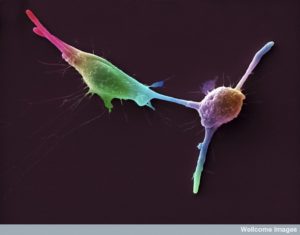 Bacteria and viruses exhibit communication and almost endless creativity and variation. We have no real idea just how many species there are. Bacteria and viruses have dramatic effects on the ecology of every part of the earth. Because of this, they have been considered by some to be the dominant life form. An increasing amount of research is focusing on the impact of bacteria and viruses on every aspect of our lives. But, are we assuming their importance because of the current focus of research. Or, could it be that fungi are really the most dominant life form on earth, with much less research focused on them.
Bacteria and viruses exhibit communication and almost endless creativity and variation. We have no real idea just how many species there are. Bacteria and viruses have dramatic effects on the ecology of every part of the earth. Because of this, they have been considered by some to be the dominant life form. An increasing amount of research is focusing on the impact of bacteria and viruses on every aspect of our lives. But, are we assuming their importance because of the current focus of research. Or, could it be that fungi are really the most dominant life form on earth, with much less research focused on them.
While able to communicate with their own community, as other microbes do, fungi are also known to communicate cooperatively with plants. Remarkably, they can sense, make decisions and signal as one microscopic cell like bacteria, but also exist as huge multi cellular creatures that can be 3 square miles in area and 9000 years old. It is surprising to note that one million people are killed every year by fungi. They kill more than malaria. Research into the life of fungi is just beginning. This post will describe some of the early descriptions of the vast number and varieties of their species.
Many Different Kinds of Fungus
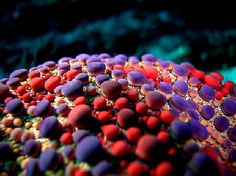 Fungus can be single celled yeasts and molds or multi cellular organisms producing fruiting bodies and mushrooms. Fungus are different from plants and bacteria and its walls are uniquely made of chitin. Like animals they absorb dissolved molecules to eat after putting out enzymes to digest their food.
Fungus can be single celled yeasts and molds or multi cellular organisms producing fruiting bodies and mushrooms. Fungus are different from plants and bacteria and its walls are uniquely made of chitin. Like animals they absorb dissolved molecules to eat after putting out enzymes to digest their food.
Spores fly in the air to new locations, but most fungi move by growing hyphae or long wires. One of their major activities is decomposing organic material like trees and cycling nutrients throughout the environment. They can be delicious, such as mushrooms, truffles, leavening in bread, wine and beer. They produce antibiotics, detergents and pesticides, psychotropics and psychedelics.
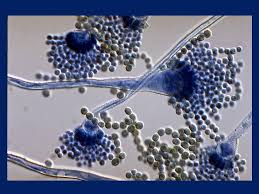 Hyphae are thread like cylinders that can grow from microscopic to visible sizes. They branch and grow at tips. They form networks that can be huge called mycelium. Segments can have individual nuclei or they can be continuous.
Hyphae are thread like cylinders that can grow from microscopic to visible sizes. They branch and grow at tips. They form networks that can be huge called mycelium. Segments can have individual nuclei or they can be continuous.
Specialized structures can grow at the ends of hyphae such as the haustoria for sucking nutrients out of other creatures.
A unique structure is built in cooperation with plants to manufacture usable nitrogen in exchange for other nutrients. These arbuscles of mycorrhizal fungi in plants engage in very elaborate communication at every step of the complex process. (See post.)
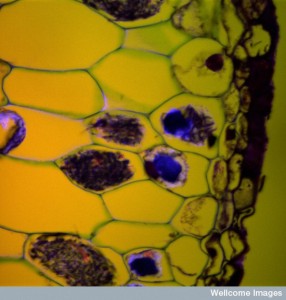 To make nitrogen factories, plants invite fungus in with elaborate back and forth signals. Plants use special calcium signaling to show the fungus (and bacteria) where they want to build the factory. Chemical signals go back and forth between the fungus and the plant. But also mechanical forces of a single fungus cell are registered by the plant as a signal. Plants can determine if a fungus is friendly or not. One touch can begin a lengthy cooperative cycle or resistance. When the plant senses danger it poisons the fungus cell to save itself.
To make nitrogen factories, plants invite fungus in with elaborate back and forth signals. Plants use special calcium signaling to show the fungus (and bacteria) where they want to build the factory. Chemical signals go back and forth between the fungus and the plant. But also mechanical forces of a single fungus cell are registered by the plant as a signal. Plants can determine if a fungus is friendly or not. One touch can begin a lengthy cooperative cycle or resistance. When the plant senses danger it poisons the fungus cell to save itself.
These arbuscular mycorrihizal root nitrogen factories allowed plants to live on the land 500 million years ago. Fungi diverged from animals about a billion years ago. When fungus developed the ability to break down the tough lignin of trees 300 million years ago, it dramatically altered forests and soils around the earth.
Fungus Can Be Huge and Tiny
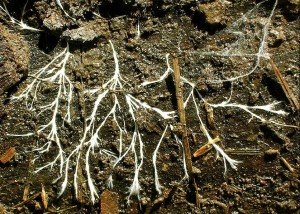 Mycelium can be huge, such as Armillaria solidipes, which is 9000 years old and occupies 3.5 square miles. Mycelium can travel under the bark of trees eating sapwood and become the largest living creature. In Oregon Malheur National Forest a mycelium is 2400 years old and is 3.4 square miles.
Mycelium can be huge, such as Armillaria solidipes, which is 9000 years old and occupies 3.5 square miles. Mycelium can travel under the bark of trees eating sapwood and become the largest living creature. In Oregon Malheur National Forest a mycelium is 2400 years old and is 3.4 square miles.
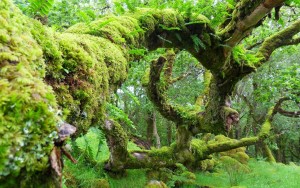 Wires formed from hyphae travel between most plants in the forest for miles connecting all of the trees. These are used for communication, such as warning of predators among plants, and a source of nutrient sharing. Plants can cut off the fungus in certain situations. It is clear that elaborate communication occurs in these wires.
Wires formed from hyphae travel between most plants in the forest for miles connecting all of the trees. These are used for communication, such as warning of predators among plants, and a source of nutrient sharing. Plants can cut off the fungus in certain situations. It is clear that elaborate communication occurs in these wires.
Fungal wires known as hyphae wrap around all plants, animals, and even bacteria. They are all through the soil.
Dominant Life Form with Large Networks
 Even though it appears that fungi in many ways are the dominant life form on earth, science is just now beginning to describe the almost infinite different forms. Dangerous fungi attack plants in the tropics, which has stimulated enormous plant diversity. Half appear to be dangerous to humans.
Even though it appears that fungi in many ways are the dominant life form on earth, science is just now beginning to describe the almost infinite different forms. Dangerous fungi attack plants in the tropics, which has stimulated enormous plant diversity. Half appear to be dangerous to humans.
They are quite different from all other living creatures. They can emerge in many different ways. They can form large interconnected creatures that will work together on the microscopic scale as well as the scale of miles.
Fungi are incredible at building networks with their hyphae, or interconnected filament forms. Fungi are very ingenious and can survive as a single cell, in groups of single cells and in huge interconnected networks that can go on for miles. Fungi with hyphae are the most prominent in the world. When fungi helped plants come onto land with hyphae wires for support, they developed a general ability to form symbiotic relationships with these hyphae. As they spread over land, they created many unique niche species.
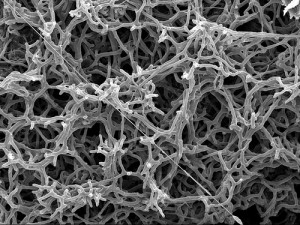 As hyphae, fungi can sense molecules at the size of microscopic microbes. Fungi coordinate activity in mycelium which can be made of many different forms at the same time, but interconnected. They eat by taking up organic compounds that are dissolved. They are very good at decomposing organic material and they synthesize a huge amount of organic acids and enzymes. They are able to take on some of the worst man made chemicals in this way.
As hyphae, fungi can sense molecules at the size of microscopic microbes. Fungi coordinate activity in mycelium which can be made of many different forms at the same time, but interconnected. They eat by taking up organic compounds that are dissolved. They are very good at decomposing organic material and they synthesize a huge amount of organic acids and enzymes. They are able to take on some of the worst man made chemicals in this way.
Fungi Respond to Different Environments
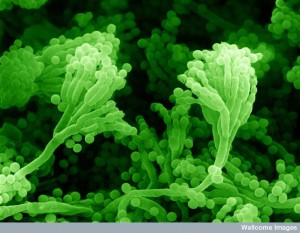 Fungi respond dramatically to different environments. They are very difficult to study however, because we lack the ability to culture most of them in laboratories. Now DNA categorization is being used. Thus far studies have mainly been in various soils and in plants, but a few studies have looked at the ocean, animals and humans. There has been an unproven assumption that most fungi are in soils and plants, and in fact there is a great amount of different species in soils. One recent study noted more than 80,000 species in soils around the world.
Fungi respond dramatically to different environments. They are very difficult to study however, because we lack the ability to culture most of them in laboratories. Now DNA categorization is being used. Thus far studies have mainly been in various soils and in plants, but a few studies have looked at the ocean, animals and humans. There has been an unproven assumption that most fungi are in soils and plants, and in fact there is a great amount of different species in soils. One recent study noted more than 80,000 species in soils around the world.
With these new genetic categorization techniques, more species are being found every day. For these genetic studies one particular place has become the barcode. It is called the internal transcribed spacer (ITS) region of nuclear rRNA operon. But, this technique has limits where variation is not related to ITS and some of the research is skewed because of its use as the major classifying tool.
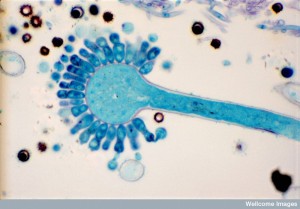 There are other issues purely related to the types of sequences and the database. Many assumptions have already been overthrown with this genetic research—much more diversity than previously thought, particularly more in specific local communities. Estimates now have increased to at least 6 million species by looking at soil and plants. There are big differences however at different latitudes where warmer climates appear to have much more. But, these estimates don’t include ocean and other waterways or animals.
There are other issues purely related to the types of sequences and the database. Many assumptions have already been overthrown with this genetic research—much more diversity than previously thought, particularly more in specific local communities. Estimates now have increased to at least 6 million species by looking at soil and plants. There are big differences however at different latitudes where warmer climates appear to have much more. But, these estimates don’t include ocean and other waterways or animals.
All species that are found appear to also exist in the soil. In soil there is a very high count of Basidiomycota and mycorrhizal fungi. Basidiomycota includes many of the most dominant and abundant species such as those that eat wood and most of the mushrooms. Mycorrhizal form vital symbiotic relationships with plants to get plants nitrogen. They associate with roots and exchange many nutrients and signals.
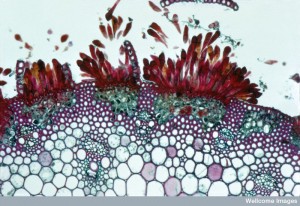 Fungi that live peacefully in plants are very common. One tree in Hawaii has more than 2500 species alone. Each root system can have more than 100 different species of nitrogen producing symbiotic fungi. The many root and leaf fungi are mostly different. Both are in the soil and many eat plants after they die, but with great competition from other soil fungi.
Fungi that live peacefully in plants are very common. One tree in Hawaii has more than 2500 species alone. Each root system can have more than 100 different species of nitrogen producing symbiotic fungi. The many root and leaf fungi are mostly different. Both are in the soil and many eat plants after they die, but with great competition from other soil fungi.
The few studies of animal and waterways show many unique forms of fungi, and every study always finds more than expected. One type found in fresh water recently is single celled with flagella. They are parasites of other algae and fungi. These might be closest to the first divergence of fungi from animals a billion years ago.
Human skin, as far as we know has a smaller number of fungi, including Candida causing thrush and other infections and Basidiomycota causing dandruff. Fungi similar to these two are frequent on coral as well.
Global Fungi
 In different regions of the globe from a size of 100 miles to a thousand miles, there are very different types of species. There are some early fungi that appear everywhere—Russula, Boletus, Inocybe, Amanita. The biggest differences are from North and South hemispheres. This goes along with the theory of the ancient Gondwana supercontinent of South America, Antarctica, New Zealand and Australia.
In different regions of the globe from a size of 100 miles to a thousand miles, there are very different types of species. There are some early fungi that appear everywhere—Russula, Boletus, Inocybe, Amanita. The biggest differences are from North and South hemispheres. This goes along with the theory of the ancient Gondwana supercontinent of South America, Antarctica, New Zealand and Australia.
Studies show that most species of fungi cannot cross oceans, and are altered by climate and isolation. Local types of fungi can identify where a soil sample comes from. Some travel in the air for certain distances and can travel as plants migrate because of climate change. Unique patterns of air travel occur in the Arctic because of unusual climate changes.
Fungi on Animals and Plants
 Much of the patterns of species found on animals and plants are related to latitude and climate. In different latitudes, there is different rainfall, activity, size, and age of the ecology. Fungi don’t always follow these patterns of diversity. Some species are only in tropical rain forests. Species of root symbiosis for nitrogen fixation appear to have greater diversity in mid latitudes. They don’t respond to just a large number of species of trees. Human associated fungi can be greater away from the tropics.
Much of the patterns of species found on animals and plants are related to latitude and climate. In different latitudes, there is different rainfall, activity, size, and age of the ecology. Fungi don’t always follow these patterns of diversity. Some species are only in tropical rain forests. Species of root symbiosis for nitrogen fixation appear to have greater diversity in mid latitudes. They don’t respond to just a large number of species of trees. Human associated fungi can be greater away from the tropics.
History and climate have big impact on the species with plants and animals. Activity of humans has altered many factors that increased fungal pathogens. Plants and animals have been devastated by fungi as a result of changes in human activity. There is much more to be learned about fungus in human health and disease.
Environmental Factors
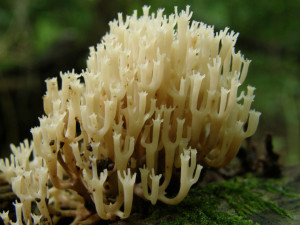 Moisture is the single biggest factor in extending hyphae wiring. Moisture keeps the pressure of the long wires intact and also helps the diffusion of nutrients into the hyphae at the membrane. Moist areas of human skin provide great differences in the number of species. Feet are warm and moist and have up to 100 species of fungi, whereas the back has only up to 10. In rainforests, the same occurs with much greater number of species at the bottom and much less at the top where the sun shines. Soil in rain forests have the most species and are proportional to the amount of rain.
Moisture is the single biggest factor in extending hyphae wiring. Moisture keeps the pressure of the long wires intact and also helps the diffusion of nutrients into the hyphae at the membrane. Moist areas of human skin provide great differences in the number of species. Feet are warm and moist and have up to 100 species of fungi, whereas the back has only up to 10. In rainforests, the same occurs with much greater number of species at the bottom and much less at the top where the sun shines. Soil in rain forests have the most species and are proportional to the amount of rain.
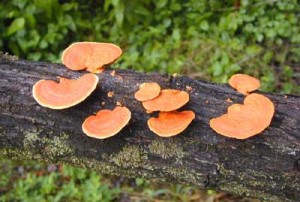 Nutrients also drive fungi. This is mostly carbon from plants. There are less fungi deep in the soil. The bottom feeders in soil have the ability to tackle the most difficult products such as lignin and tannin. Other common types are the nitrogen providers and these exchange for other nutrition from roots.
Nutrients also drive fungi. This is mostly carbon from plants. There are less fungi deep in the soil. The bottom feeders in soil have the ability to tackle the most difficult products such as lignin and tannin. Other common types are the nitrogen providers and these exchange for other nutrition from roots.
Surprisingly, temperature is not much of a factor. Also the amount of CO2 in the atmosphere doesn’t seem to affect it much.
First Arrival Rules
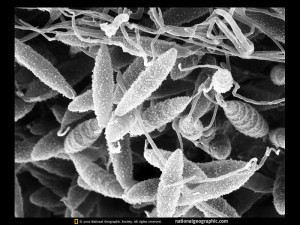 Remarkably, there is enormous variation in small regions, such as samples from two nearby soil samples, or different roots of nearby plants. Some of this is dependent upon very small local differences in nutrients and moisture.
Remarkably, there is enormous variation in small regions, such as samples from two nearby soil samples, or different roots of nearby plants. Some of this is dependent upon very small local differences in nutrients and moisture.
But some is based on who was there first. Fungi are strong competitors and just being the earliest type gives a huge advantage against others. The travel of spores previously will often determine which is the strongest.
The fungi that takes root first, can dramatically alter the environment, with great influences on ecology. For example, differences in arrival of tree eating fungi showed dramatic variations in the amount of other species that occurred later. Also, the amount of oxygen in the region was quite different with these varied arriving species. Some species have stronger more durable spores, which influences the outcomes. This historical effect helps create great differences in diversity in specific regions.
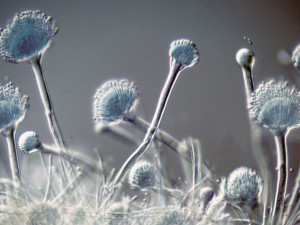 There are many individual distinct species that take over small regions. But, when looking at very large areas these small distinctions even out. Therefore, when studying a particular moisture and a particular nutrient level, even with great differences in small regions, they are statistically stable over the large region.
There are many individual distinct species that take over small regions. But, when looking at very large areas these small distinctions even out. Therefore, when studying a particular moisture and a particular nutrient level, even with great differences in small regions, they are statistically stable over the large region.
Cooperation Among Fungi Species
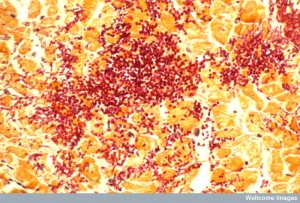 There are three large categories of fungi and then many that work together as guilds with similar activity.
There are three large categories of fungi and then many that work together as guilds with similar activity.
Saprotrophs eat decaying materials.
Mutualists include nitrogen fixing symbionts.
When humans give plants nitrogen, this limits the effectiveness of the mutualist fungus function. These fungi can make a wide variety of enzymes to break down many products and biopolymers. They are able to use resulting products as well. They release protein enzymes (proteases) and special redox enzymes. They can also have elaborate enzymes for particular nitrogen species. White and brown rot have many different enzymes that are often used and quite rare.
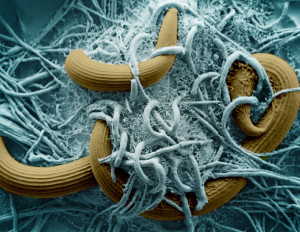 Pathogens have much greater amounts of genes that make varied enzymes and toxins.
Pathogens have much greater amounts of genes that make varied enzymes and toxins.
Both Saprotrophs and pathogens include white and brown rot.
Surprisingly, different species of fungi appear to work together for survival. These are often referred to as functional guilds. Just as they help plants with sending danger signals and producing nutrition, fungi produce specific species that work together for survival in different situations.
Recent research shows that innocent fungi in plants may actually be very beneficial to the plants as protection against pathogens. Others might encourage disease. Most of the friendly fungi in plants also house dormant species of decomposers for that eventuality.
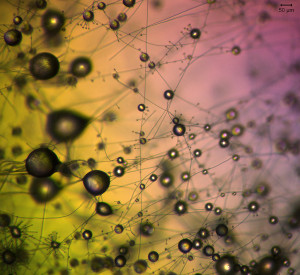 In regions with less nitrogen, there is more communication and intermingling of fungus species. Having less nitrogen increases communication between species related to plants and the larger wires across the forest. Another result is that decomposers are stimulated to create more food for everyone. This increases competition with local bacteria that also decompose plants.
In regions with less nitrogen, there is more communication and intermingling of fungus species. Having less nitrogen increases communication between species related to plants and the larger wires across the forest. Another result is that decomposers are stimulated to create more food for everyone. This increases competition with local bacteria that also decompose plants.
These alterations can occur based on specific types of hyphae that travel into new areas seeking help. Hyphae can locate new sources of food through searching, a form of foraging for the fungi community. The fungi community uses both small location information as well as global forest wide information to adapt.
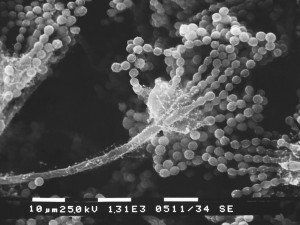 In one small area, rather than having only one species perform particular functions, groups of species work at the same task in different ways. A study of the pine forests in America showed many different distinct species with almost identical amounts of breakdown of cellulose. These can be altered by historical domination of particular species and also alterations of environment creating specific new needs.
In one small area, rather than having only one species perform particular functions, groups of species work at the same task in different ways. A study of the pine forests in America showed many different distinct species with almost identical amounts of breakdown of cellulose. These can be altered by historical domination of particular species and also alterations of environment creating specific new needs.
The subtle differences of the species in a guild determine what happens when the environment and needs change in the local region. One species may become much more active. More often many in the guild operate the same way.
Fungi and Bacteria
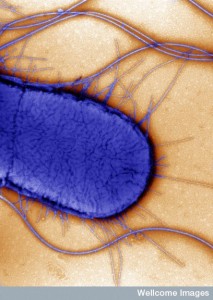 With only very recent studies related to the vastness of fungi, they have been considered to be similar to bacteria in many ways. But, they are not. There has been much more study of bacteria, even though fungi are probably more prominent in determining large-scale natural events. Some studies now include both at the same time.
With only very recent studies related to the vastness of fungi, they have been considered to be similar to bacteria in many ways. But, they are not. There has been much more study of bacteria, even though fungi are probably more prominent in determining large-scale natural events. Some studies now include both at the same time.
Fungi are able to tolerate acid and are not as vulnerable to changes in pH. Bacteria are, on the other hand, very dependent on pH. Fungi are much more reactive to climate changes. With bacteria, those on land and in the ocean appear to be quite different with different effects on ecology. For fungi, there is much less difference. It appears that many of the ocean fungi came from those on land.
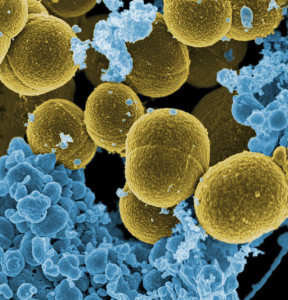 There seems to be more diversity among bacteria in general, twice as much in soil, an order of magnitude in ocean and animals. Fungi are more distinct by region and more similar in local regions than bacteria.
There seems to be more diversity among bacteria in general, twice as much in soil, an order of magnitude in ocean and animals. Fungi are more distinct by region and more similar in local regions than bacteria.
In the same regions, symbiotic root fungi have more species with more calcium in the soil, unlike bacteria. There are no correlations in diversity between the bacteria and fungi in geographical regions.
The differences between bacteria and fungi perhaps complicate approaches to disease. Because of inadequacies of the studies on fungus currently, some of the current information may not be correct.
Are Fungus the Dominant Life Form
 While communication among bacteria and with plants and animals has been well documented, perhaps even more elaborate signaling occurs in fungal wires. Since fungal wires connect almost all trees and plants in large forests, signals are able to be sent out in large areas. Some of the signals are related to predators in certain areas warning other plants even far away. Other uses of the wires are for nutrient sharing.
While communication among bacteria and with plants and animals has been well documented, perhaps even more elaborate signaling occurs in fungal wires. Since fungal wires connect almost all trees and plants in large forests, signals are able to be sent out in large areas. Some of the signals are related to predators in certain areas warning other plants even far away. Other uses of the wires are for nutrient sharing.
Much more is currently known about bacteria and viral signaling. Communication among bacteria is known to be very complex.
Considerable more research must be done on fungus communication, especially signaling that occurs with cooperation among its guilds and with plants in the large forest. With fungi bridging the very small and the very large in the same creature, much needs to be learned about its communication and interactions with human life.